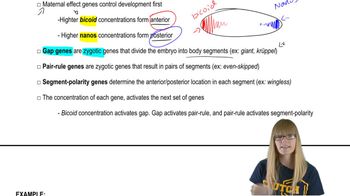A powerful approach to identifying genes of a developmental pathway is to screen for mutations that suppress or enhance the phenotype of interest. This approach was undertaken to elucidate the genetic pathway controlling C. elegans vulval development. A lin-3 loss-of-function mutant with a vulva-less phenotype was mutagenized. Based on your knowledge of the genetic pathway, what types of mutations will suppress the vulva-less phenotype?
Table of contents
- 1. Introduction to Genetics51m
- 2. Mendel's Laws of Inheritance3h 37m
- 3. Extensions to Mendelian Inheritance2h 41m
- 4. Genetic Mapping and Linkage2h 28m
- 5. Genetics of Bacteria and Viruses1h 21m
- 6. Chromosomal Variation1h 48m
- 7. DNA and Chromosome Structure56m
- 8. DNA Replication1h 10m
- 9. Mitosis and Meiosis1h 34m
- 10. Transcription1h 0m
- 11. Translation58m
- 12. Gene Regulation in Prokaryotes1h 19m
- 13. Gene Regulation in Eukaryotes44m
- 14. Genetic Control of Development44m
- 15. Genomes and Genomics1h 50m
- 16. Transposable Elements47m
- 17. Mutation, Repair, and Recombination1h 6m
- 18. Molecular Genetic Tools19m
- 19. Cancer Genetics29m
- 20. Quantitative Genetics1h 26m
- 21. Population Genetics50m
- 22. Evolutionary Genetics29m
14. Genetic Control of Development
Developmental Patterning Genes
Problem 21
Textbook Question
The floral homeotic genes of Arabidopsis belong to the MADS-box gene family, while in Drosophila, homeotic genes belong to the homeobox gene family. In both Arabidopsis and Drosophila, members of the Polycomb gene family control expression of these divergent homeotic genes. How do Polycomb genes control expression of two very different sets of homeotic genes?
 Verified step by step guidance
Verified step by step guidance1
Understand the role of Polycomb genes: Polycomb genes are a group of genes that encode proteins involved in epigenetic regulation. They control gene expression by modifying chromatin structure, making certain regions of DNA more or less accessible for transcription.
Recognize the conserved mechanism: Despite the differences in the homeotic gene families (MADS-box in Arabidopsis and homeobox in Drosophila), Polycomb genes regulate both by repressing gene expression through chromatin remodeling. This is a conserved mechanism across species.
Explain chromatin remodeling: Polycomb proteins form complexes, such as Polycomb Repressive Complex 1 (PRC1) and Polycomb Repressive Complex 2 (PRC2). PRC2 adds methyl groups to histone H3 at lysine 27 (H3K27me3), a modification associated with transcriptional repression. PRC1 recognizes this mark and compacts chromatin further.
Apply this to homeotic genes: In both Arabidopsis and Drosophila, Polycomb complexes repress the expression of homeotic genes in regions where they should not be active. This ensures proper spatial and temporal expression patterns during development.
Conclude the shared principle: Although the specific homeotic genes differ between Arabidopsis and Drosophila, the Polycomb gene family uses the same epigenetic mechanisms to regulate their expression, highlighting the evolutionary conservation of this regulatory system.
 Verified video answer for a similar problem:
Verified video answer for a similar problem:This video solution was recommended by our tutors as helpful for the problem above
Video duration:
2mPlay a video:
Was this helpful?
Key Concepts
Here are the essential concepts you must grasp in order to answer the question correctly.
Homeotic Genes
Homeotic genes are crucial for determining the identity of body parts during development. In organisms like Arabidopsis and Drosophila, these genes dictate the formation of specific structures, such as flowers in plants or segments in insects. They are categorized into different families, such as MADS-box in plants and homeobox in animals, reflecting their evolutionary divergence yet functional similarities.
Recommended video:
Guided course

Segmentation Genes
Polycomb Group Genes
Polycomb group (PcG) genes are a set of regulatory genes that maintain the repression of target genes through epigenetic mechanisms. They play a vital role in developmental processes by ensuring that homeotic genes are expressed at the right time and place. In both Arabidopsis and Drosophila, PcG proteins modify chromatin structure, thereby silencing specific homeotic genes to prevent inappropriate expression.
Recommended video:
Guided course

Mapping Genes
Epigenetic Regulation
Epigenetic regulation refers to heritable changes in gene expression that do not involve alterations to the underlying DNA sequence. This includes mechanisms such as DNA methylation and histone modification, which can activate or silence genes. In the context of Polycomb genes, epigenetic regulation is essential for controlling the expression of homeotic genes, allowing for precise developmental outcomes despite the genetic differences between species.
Recommended video:
Guided course

Regulation
Related Videos
Related Practice
Textbook Question
568
views


